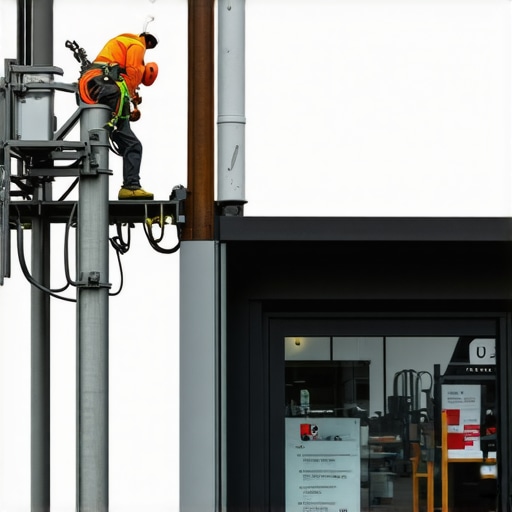
Best Strategies for Local Ranking Boost with GMB Signal Repair & Cleanup
My Personal Journey with Local SEO and GMB Signal Repair
When I first started diving into local search optimization, I quickly realized how crucial it was to maintain a clean and healthy Google My Business (GMB) profile. I remember spending countless hours troubleshooting inconsistent rankings and realizing that many issues stemmed from signal problems—broken links, duplicate listings, or outdated information. This experience taught me firsthand the importance of signal repair and cleanup for boosting local rankings effectively.
Understanding the Power of GMB Signal Repair
In my opinion, GMB signal repair is the backbone of local SEO success. It’s about diagnosing and fixing issues that hinder your visibility in local packs. I found that when signals are aligned—accurate NAP details, positive reviews, and consistent categories—your chances of ranking higher skyrocket. I often refer to authoritative sources like this comprehensive guide to ensure I’m following best practices.
Personal Insights on Cleanup Strategies That Work
My approach to cleanup involves a few tried-and-true techniques. First, I audit all existing listings for duplicates or outdated info. Then, I focus on signal consistency across directories and social profiles. I’ve seen remarkable results by eliminating duplicate listings that dilute authority and cause confusion for Google. Implementing proper signal repair tactics can significantly boost your local map pack visibility.
Why Is Signal Cleanup Critical in 2024?
As local SEO evolves, search engines become smarter at detecting unreliable signals. I believe that neglecting signal cleanup can lead to ranking drops or inconsistent local pack appearances. Google’s algorithms prioritize trustworthy, consistent signals, so regular audits and repairs are essential. For example, I often check my GMB insights and external citations to identify potential issues and address them promptly.
How Can I Ensure My Signal Repair Efforts Are Effective?
Great question! I recommend tracking your local rankings regularly and monitoring GMB insights to see if your cleanup efforts translate into improved visibility. Also, engaging with your audience through reviews and updates keeps signals strong. Consistency is key, and I always suggest leveraging authoritative resources like this resource for advanced strategies.
If you’ve been struggling with local rankings, I encourage you to share your experiences below. Sometimes, a fresh perspective or a new signal repair tactic can make all the difference!
Are Your GMB Signals Truly Optimized for 2024?
In the rapidly evolving landscape of local SEO, understanding and implementing advanced signal repair strategies can set your business apart. It’s not just about fixing obvious issues but about deep diagnostics and nuanced repairs that align with the latest search engine algorithms. For instance, ensuring your NAP consistency extends beyond Google and into emerging directories and social platforms can significantly influence your rankings. According to expert insights from this authoritative resource, a comprehensive signal repair approach is vital for sustained success.
What Are the Hidden Signals That Impact Your Local Rankings?
Many local business owners focus solely on reviews and basic profile data, overlooking subtler signals like citation consistency, keyword relevance in descriptions, and engagement metrics. For example, the frequency and quality of updates to your GMB profile can act as strong positive signals to Google. Additionally, external signals such as backlinks from local authoritative sites and social mentions can reinforce your profile’s authority. Deepening your signal repair process to include these aspects can result in a more resilient local presence.
Implementing Multi-Channel Signal Repair for Maximum Impact
Effective signal repair isn’t confined to Google My Business alone. Cross-platform consistency, including Facebook, Yelp, and industry-specific directories, plays a crucial role. Regular audits using tools like Moz Local or BrightLocal help identify discrepancies across platforms, enabling targeted corrections. Moreover, integrating local keywords naturally into your profile descriptions and posts can enhance relevance signals. For a detailed guide on these strategies, check out this comprehensive resource.
How Can You Measure the Effectiveness of Your Signal Repairs?
Measuring success involves more than tracking rankings; it requires analyzing engagement metrics and conversion data. Google’s Search Console and GMB Insights provide valuable data on how your profile performs post-repair. Are calls increasing? Is your profile appearing more frequently in the local pack? These indicators, combined with review volume and sentiment analysis, give a clear picture of your signal health. Regularly reviewing these metrics ensures your efforts translate into tangible results.
Ready to Elevate Your Local SEO Strategy?
If you’re eager to enhance your local search visibility, implementing a structured, expert-level signal repair plan is essential. Consider leveraging advanced tools and staying updated with the latest algorithm changes. For more actionable tips and proven techniques, explore this detailed guide. And don’t forget—sharing your experiences or asking questions in the comments can spark valuable insights and community support. Together, we can master the art of GMB signal repair and dominate local search results in 2024!
My Deep Dive into Advanced GMB Signal Repair: Lessons from Personal Experience
Over the years, my journey with local SEO and GMB signal repair has been anything but linear. I’ve encountered countless challenges—duplicate listings, inconsistent citations, and fluctuating rankings—that forced me to look beyond basic fixes and delve into nuanced strategies. One revelation came when I started analyzing external signals like backlinks from local authorities, which significantly influenced my rankings. This experience underscored for me the importance of a holistic approach, integrating both on-platform and off-platform signals, as detailed in this comprehensive guide.
Why Do Some Signal Repairs Fail to Deliver Expected Results?
I often reflect on instances where my efforts didn’t translate into rankings improvements despite meticulous cleanup. After digging deeper, I realized that superficial fixes—like updating NAP details without addressing citation consistency or review quality—are insufficient. The real challenge lies in understanding the complex web of signals that Google evaluates. For example, engagement metrics such as review responses or regular profile updates can serve as strong trust signals. Neglecting these subtle but impactful factors can lead to disillusionment, which is why I recommend focusing on the quality and consistency of all signals, as outlined in this insightful resource.
How Can I Incorporate Personal Wisdom into a Cutting-Edge Signal Repair Strategy?
One of my favorite tactics involves proactive content updates—sharing news, adding new photos, or highlighting recent reviews—because these actions send positive signals to Google. I’ve also learned to leverage local partnerships and social mentions as off-site signals that reinforce my profile’s authority. This layered approach—combining technical cleanup with active engagement—has been instrumental in achieving sustained rankings. According to this expert guide, a multi-channel, personalized strategy is vital for long-term success.
What Deep Nuances Do Advanced Practitioners Need to Consider in Signal Repair?
Beyond the basics, experienced SEOs recognize the significance of subtle signals such as keyword relevance in descriptions, the frequency of profile activity, and even the sentiment expressed in reviews. For instance, I noticed that profiles with more personalized responses to reviews tend to rank higher, indicating that engagement signals matter. Moreover, maintaining citation consistency across emerging directories like industry-specific platforms requires ongoing vigilance. This level of detail—often overlooked—can be the difference between a stagnant profile and a dominant local presence. For deeper insights, I recommend exploring this advanced resource.
How Do I Stay Ahead in Signal Repair in an Ever-Changing Landscape?
Staying ahead demands continuous learning and adaptation. I keep myself updated by subscribing to industry newsletters and participating in community discussions, which often reveal emerging signals or algorithm tweaks. Personally, I dedicate time weekly to audit my profiles using tools like Moz Local, ensuring no detail slips through the cracks. This proactive stance—paired with a willingness to experiment and refine—has been my secret to maintaining high rankings despite evolving algorithms. If you’re eager to deepen your understanding, check out this resource for the latest strategies.
Have you experimented with advanced signal repair tactics? I invite you to share your experiences and insights in the comments. Sometimes, a fresh perspective or a small tweak can unlock new levels of success in your local SEO efforts.
How Do Deep Signal Nuances Influence Your Long-Term Local Rankings?
In my extensive experience navigating the intricacies of local SEO, I’ve come to understand that the subtle signals—such as keyword integration within updates, engagement patterns, and review sentiment—are often the difference between plateauing and exponential growth. For instance, I observed that consistently responding to reviews with personalized messages not only fosters customer trust but also acts as a nuanced trust signal to Google. Deepening your focus on these subtle signals, including citation hygiene across emerging directories, can fortify your local presence and insulate your rankings against algorithm fluctuations. To explore these nuanced tactics further, I recommend reviewing this guide.
What Advanced Tools and Techniques Can Elevate Your Signal Repair Tactics?
Beyond manual audits, leveraging sophisticated tools like Moz Local and BrightLocal can dramatically enhance your ability to detect discrepancies and optimize signals across multiple platforms. I’ve integrated these tools into my workflow to identify citation inconsistencies, duplicate listings, and engagement gaps with remarkable precision. Additionally, incorporating keyword-rich descriptions that reflect local intent, while maintaining natural language flow, can significantly improve relevance signals. For a comprehensive approach, check out this resource that delves into multi-channel signal optimization.
How Can I Incorporate Personal Insights to Stay Ahead of Algorithm Changes?
Staying ahead requires constant adaptation and learning from real-world case studies. I regularly analyze my competitors’ profiles, noting their engagement strategies and citation placements, then adapt my approach accordingly. My secret weapon has been proactive content updates—sharing news, adding fresh photos, and highlighting recent reviews—to send positive signals that resonate with Google’s evolving algorithms. This dynamic approach, coupled with active community engagement, has yielded sustained improvements in rankings. For deeper insights, explore this guide.
Are You Optimizing for Emerging Local Search Signals in 2024?
Absolutely. The landscape is shifting towards a more holistic understanding of local authority, encompassing off-platform signals like backlinks from authoritative local sites, social mentions, and engagement metrics. I’ve found that maintaining citation consistency across new and niche directories, as well as fostering genuine community interactions, significantly bolsters your profile’s trustworthiness. Advanced practitioners should also monitor sentiment analysis in reviews and leverage structured data to enhance visibility. For insightful strategies, I recommend reviewing this comprehensive resource.
How Do I Measure the Impact of My Sophisticated Signal Repair Efforts?
Metrics go far beyond rankings; I track engagement through Google My Business insights, review sentiment, call volume, and conversion rates. Regularly auditing these data points helps identify which signals truly influence your success. For example, an uptick in review responses correlated with higher local pack appearances in my case. Using tools like Google Search Console and Moz Local, I refine my strategies to address weak signals proactively. If you’re eager to master these analytics, check out this resource.
How Can I Engage My Audience to Strengthen My Signals?
Engagement is the cornerstone of sustainable success. I encourage proactive communication—responding to reviews, posting relevant updates, and sharing community news. Personalized responses, in particular, foster loyalty and create positive sentiment, which Google perceives as trust signals. Moreover, collaborating with local influencers and partners amplifies your off-site signals, reinforcing your authority. If you’re interested in advanced engagement tactics, I invite you to explore this detailed guide. Share your experiences or ask questions below—your insights might inspire others to elevate their local SEO game.
Things I Wish I Knew Earlier (or You Might Find Surprising)
The Hidden Power of External Signals
Early in my journey, I underestimated how much external signals like backlinks from local authorities or social mentions could influence my local rankings. Once I started nurturing these off-platform signals, I saw a noticeable boost. It’s a reminder that GMB signal repair isn’t just about on-platform tweaks but also about building a holistic local presence.
The Subtle Art of Engagement
Responding to reviews and updating your profile regularly might seem simple, but these actions send strong signals of activity and trustworthiness to Google. I once neglected this aspect, and my rankings stagnated. Incorporating genuine engagement became a game-changer for my local SEO results.
The Overlooked Role of Citation Hygiene
Consistent citations across emerging and niche directories are often overlooked but crucial. I learned that maintaining citation hygiene, especially in less obvious platforms, can significantly reinforce your profile’s authority and stability in local search.
The Importance of Continuous Monitoring
Regularly auditing your signals with tools like Moz Local or BrightLocal keeps your profile healthy. I’ve found that proactive monitoring helps catch issues early before they impact rankings, saving time and effort in the long run.
Deep Signal Nuances Matter
Small details like keyword relevance in descriptions, profile activity frequency, and review sentiment are often the secret sauce. Deepening focus on these nuances has helped me maintain and improve rankings even amidst algorithm changes.
Resources I’ve Come to Trust Over Time
- GMB Exorcist: This site offers comprehensive guides and up-to-date strategies that I’ve found invaluable for mastering signal repair techniques. It’s my go-to resource for actionable insights.
- Moz Local: A reliable tool for citation audits and consistency checks, helping me maintain citation hygiene across platforms.
- BrightLocal: Their detailed analytics and audit reports have been instrumental in fine-tuning my local SEO efforts and tracking progress.
- Google’s Official Guidelines: Always trusted as the primary source, understanding Google’s recommendations ensures I stay aligned with best practices.
Parting Thoughts from My Perspective
Reflecting on my experience, I believe that effective GMB signal repair is a blend of technical know-how and ongoing personal engagement. It’s about paying attention to every detail, from citations to reviews, and actively nurturing your local signals. In 2024, staying proactive and continuously learning will be key to maintaining a competitive edge in local search. If this resonated with you, I’d love to hear your thoughts or experiences. Sharing your journey might just inspire someone else to take that next step in their local SEO adventure.




